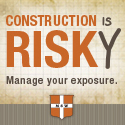
| www.agc.org • May 2016 |
Contact Us Archives
Subscribe Printer-Friendly AdvertiseSafety and HealthFacebook |
Close Quarters: OSHA's Confined Spaces Rule Raises the Bar for Construction Site Safety BY SHERYL JACKSON More than 20 years ago, the Occupational Safety and Health Administration (OSHA) issued a rule defining confined spaces and safety precautions for workers in those spaces in industrial settings. In August 2015, OSHA issued a standard that’s specific to confined spaces in construction.
Although the standard has been in development since the 1990s, many contractors were not completely prepared for the differences between the two rules. The state of compliance is a "work in progress," according to Dennis Dougherty, president and CEO of Med-Tex Services, a Philadelphia Builders Chapter and Contractors Association of Eastern Pennsylvania member. "Contractors who are safety-conscious or those who performed construction work in industrial settings were following industrial guidelines so there was no sense of urgency to adjust their processes to meet the new standard." While many of the requirements are similar, there are a few significant differences that reflect the constantly evolving, complex nature of a construction site that often involves several different trades working in and around confined spaces at the same time. "The standard clarifies roles, responsibilities and precautions, and sets a higher bar for confined space safety on a construction site," says Mike Ziskin, president of Field Safety Corporation, an AGC of Connecticut member. The construction-specific rule emphasizes hazard and risk assessment, detailed planning for normal entry and rescue operations, training, continuous worksite evaluations and communications requirements among multiple employers and trades to protect workers’ safety. "We were prepared for the rule because we do a lot of work in general industry and followed those guidelines on all of our construction sites," says Kim Esposito, risk manager at HSC Builders & Construction Managers, a Philadelphia Builders Chapter and Delaware Contractors Association member. The challenge is the expanded definition of confined space specific to general construction and the additional precautions, she says. "For example, an open elevator pit now requires atmospheric monitoring." Educating owners about the changes in the rule is an ongoing process but Bill Reis, safety director at Belcher Roofing Corp., a Philadelphia Builders Chapter member, appreciates the new rule – it makes his job easier, he says. "For example, my company has followed the general industry confined space guidelines even on construction sites. I would conduct a pre-job analysis and tell the owner that there were confined spaces, which would increase costs for additional employees, testing and monitoring, training and rescue services," he explains. "I was told that contractors before me never classified the spaces as permit-required confined spaces (PRCSs), and they did not understand why I did." Now, that OSHA has a construction-specific rule, Reis can point to the regulation and explain that there is no choice now. "OSHA took advantage of technology developed after implementation of the general industry confined space rule by requiring continuous atmospheric testing and continuous engulfment monitoring of confined spaces," explains Ziskin. Because the technology exists now, contractors are expected to use it to protect workers, he says. "The challenge with this requirement is ensuring there is early warning to detect changes in the confined space environment and prompt decisive action to remove potentially endangered entrants," he adds.
Employers are required to evaluate a rescue team's capability and availability to perform a timely rescue for employees working in confined spaces. Photo courtesy of Med-Tex Services KEY DIFFERENCES IN CONSTRUCTION-SPECIFIC RULE 1. New roles and responsibilities Because a construction site typically has many employers and trades without a history of confined spaces and their related hazards than an industrial site, the construction-specific rule addresses the need for all employers on the site to communicate with each other about the location and risks of confined spaces. Terms such as host employer, controlling contractor and entry employer reflect the complexity of multiple employers onsite. "Although the responsibility for scheduling work often falls to the general contractor, all subcontractors are responsible for making sure their employees are aware of the confined space locations and the potential impact their work can have on them – even if their workers do not enter those spaces," explains Dougherty. "Everyone on the jobsite is responsible for safety in and around confined spaces, and for communicating with all other contractors." The rule also identifies the need for a competent person to evaluate confined spaces. The competent person must assess a confined space, in accordance with other provisions of this final rule, for hazards and the necessary protection measures. This includes communication, early hazard warning systems and atmospheric monitoring needs to keep employees safe. If the space is determined to be a PRCS, a written program outlining the training and responsibilities of attendants, entrants and entry supervisors as well as detailed rescue procedures needs to be developed.
Crawl spaces, utility shafts and other unique spaces are frequently encountered during renovation work. Photo courtesy of Med-tex Services 2. Confined space training required for all employees While more extensive training is required for supervisors and employees who enter confined spaces or serve as entry attendants, all employees on a jobsite must undergo hazard awareness training when PRCSs are identified, says Esposito. "Even if a worker is only onsite for 30 minutes, they must go through a safety orientation that includes confined space information." Remember, too, that a construction site may have more than one confined space, which means safety precautions in and around those spaces may differ, points out Esposito. "Just as the safety plan for each space is different, so is the awareness training," she says. To make sure people are working in areas for which they’ve been trained properly, Esposito’s company issues hardhat stickers that indicate they’ve received the appropriate training. "On sites with multiple PRCSs, we issue different color stickers for each confined space." 3. Proactive rescue plans required "In general, most contractors do not plan rescues to the extent necessary," says Ziskin. Now, the safety plans for each confined space must address rescue procedures, and calling "911" is not adequate, he adds. "We may see more contractors train their own employees to be better prepared to handle some level of rescue, but that approach may not be effective in many situations, and proactive arrangements with rescue services are required." Although a supervisor or other employee (entry attendant) can be trained to use equipment such as a tripod for non-entry rescue, there are situations for which trained rescue personnel are better prepared, points out Ziskin. "For example, will the attendant know what to do if the victim gets hung up on something while being hoisted out, or what if the equipment is not appropriate for the job?" he says. "Calling local fire and rescue personnel only at the time of the emergency is also not as effective because they are not prepared or familiar with the space, the identified hazards and the specific equipment for an extraction. If the plan calls for local emergency personnel assistance, it is best to get them involved before the entry is performed." Perhaps the greatest reason a contractor should have well-planned rescue capability prearranged for the kinds of emergencies the confined space could represent is the fact that emergency personnel may not be available in a timely manner, or may not be able to easily reach the site in time, Ziskin adds. Ensuring compliance with the construction-specific confined space rule starts with pre-construction planning, says Esposito. "We look at confined spaces differently in our initial walk-throughs of the project, focusing on potential hazards and identifying additional safety steps that are needed," she says. "We pay close attention to those spaces as work for all trades is scheduled to make sure nothing they are doing will increase risk to employees working in those spaces." Any change to normal routines is hard, but look at the fall protection safety requirements, says Dougherty. "They created a lot of angst when first introduced but are now commonplace – in fact, rarely anyone questions the need for them," he says. "This will also happen with the confined space requirements. After all, it is about protecting workers on our construction sites." |
|||
 2300 Wilson Boulevard, Suite 300 · Arlington, VA 22201 · 703-548-3118 (phone) · 703-548-3119 (fax) · www.agc.org
2300 Wilson Boulevard, Suite 300 · Arlington, VA 22201 · 703-548-3118 (phone) · 703-548-3119 (fax) · www.agc.org
About AGC | Advocacy | Industry Topics | Programs and Events | Career Development | News & Media
© Copyright 2025 The Associated General Contractors of America. All rights reserved.



